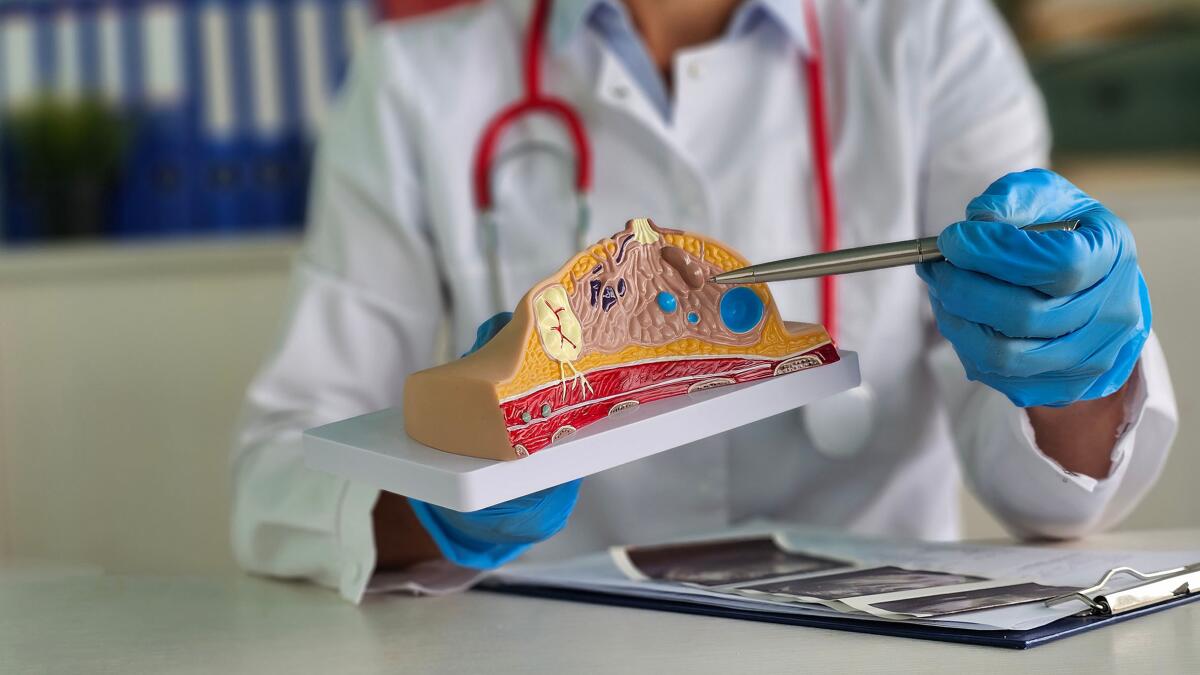Breakthrough Drugs Are Changing the Outlook for Triple-Negative Breast Cancer

- Share via
Key Facts
- Sacituzumab govitecan targets Trop-2 and delivers potent chemo directly to TNBC cells.
- PARP inhibitors are effective in TNBC patients with BRCA mutations.
- Immune checkpoint inhibitors benefit patients with PD-L1 positive tumors.
- Antibody-drug conjugates are expanding treatment options and improving survival.
- Emerging therapies focus on molecular subtypes, combinations, and immune reprogramming.
Triple-negative breast cancer (TNBC), the most difficult breast cancer to treat and more common with potentially different outcomes in African American, Hispanic, and Black women, lacks estrogen, progesterone, and HER2 receptors, rendering hormonal therapy ineffective. Recent drug developments offer hope for this high-risk subtype with a poor prognosis, highlighting the importance of ongoing research.
Table of Contents
- Sacituzumab Govitecan
- PARP Inhibitors: Targeted Therapy for BRCA-Mutated TNBC
- Immune Checkpoint Inhibitors: Harnessing the Power of Immunotherapy
- Antibody-Drug Conjugates: Expanding Treatment Options
- What’s Next? Emerging Therapies for TNBC
- Closing Thoughts
- References
Sacituzumab Govitecan
Sacituzumab govitecan is one of the biggest breakthroughs in TNBC therapy. It’s an ADC (antibody-drug conjugate) which is essentially a guided missile for cancer treatment. Sacituzumab govitecan is an FDA approved drug for certain patients with triple-negative breast cancer. [1]
This drug delivers a potent chemotherapy agent directly to cancer cells, minimizes damage to healthy tissue. Sacituzumab govitecan can be used as first line or first treatment in some advanced or metastatic cases of TNBC. [2]
Clinical trials have shown sacituzumab govitecan can extend survival in patients with advanced TNBC. This drug has given treatment options to patients who had limited treatment options.
How It Works
This drug targets Trop-2, a protein found on the surface of many TNBC cells. Sacituzumab govitecan links an anti-Trop-2 antibody to SN-38, one of the chemotherapy drugs used to kill cancer cells in triple-negative breast cancer [3]. Once the drug binds to the cancer cell, it delivers SN-38 into the cell. This targeted approach kills cancer cells while minimizing damage to normal cells.
Sacituzumab govitecan has shown to work in patients with metastatic TNBC (including advanced TNBC and metastatic breast cancer) who have received at least two prior lines of therapy. According to recent clinical trials it improves PFS and is a third line option [4].
Side Effects
Common side effects are nausea, neutropenia (low white blood cell count), diarrhea and fatigue. These are manageable but need to be monitored by healthcare providers.
PARP Inhibitors: Targeted Therapy for BRCA-Mutated TNBC
For TNBC patients who have BRCA1 or BRCA2 gene mutations, PARP inhibitors have been a game changer. A BRCA mutation can be present even in patients without family history of breast cancer, so genetic testing is important for all TNBC cases [5].
These drugs exploit the cancer cells’ weakened ability to repair DNA and cause them to self-destruct. Gene expression profiles and molecular subtype analysis can help identify which patients are most likely to benefit from these targeted therapies. Defects in DNA repair are a key contributor to cancer development in triple-negative breast cancer.
Who Benefits?
Patients with inherited BRCA mutations tend to respond well because their tumor cells already have a compromised DNA repair mechanism. Patients with high tumor mutational burden may also respond better to certain targeted therapies including PARP inhibitors. PARP inhibitors further inhibit this pathway and cause cancer cell death [6].
Clinical Significance
Drugs like olaparib and talazoparib have been approved for BRCA-mutated breast cancers including TNBC. Clinical trials have shown these treatments can delay disease progression and in some cases extend overall survival [2]. New treatments are being tested in clinical trials to further improve outcomes for BRCA-mutated TNBC patients.
Immune Checkpoint Inhibitors: Harnessing the Power of Immunotherapy
Immunotherapy has changed the cancer treatment landscape and TNBC is no exception. Immunotherapy works by enhancing the immune response against cancer cells, particularly by activating T cells to recognize and attack tumor cells.
Immune checkpoint inhibitors help the body’s immune system recognize and attack cancer cells by targeting proteins like PD-1 and PD-L1. These therapies are especially important for solid tumors like triple-negative breast cancer where cancer cells grow rapidly unchecked. [7]
Who Benefits?
Patients with PD-L1 positive tumors are the most likely to benefit. Gene expression profiles can help identify which tumors are most likely to respond to immunotherapy by providing a detailed molecular understanding of TNBC subtypes. PD-L1 testing has become a standard part of TNBC evaluation.
Why It Matters
Checkpoint inhibitors like atezolizumab and pembrolizumab have shown promise especially when used in combination with chemotherapy. Combination therapy including neoadjuvant chemotherapy or neoadjuvant treatment with immunotherapy is being studied to improve response rates in TNBC. Trials are ongoing to improve response rates and overall outcomes [3]. Adjuvant chemotherapy may also be used after surgery to reduce recurrence in TNBC patients [8].

Antibody-Drug Conjugates: Expanding Treatment Options
While sacituzumab govitecan is the front runner, other ADCs are emerging as effective tools against TNBC. These drug treatments can be tailored to specific breast cancer subtypes including triple negative breast cancers by targeting unique molecular features. These therapies combine the precision of targeted treatment with the power of traditional chemotherapy [9].
Clinical Impact
Some ADCs are already approved for TNBC, others are in late stage clinical trials. For example drugs targeting HER3 or LIV-1, two other proteins found on cancer cells are being studied in TNBC patients.
Why It’s Promising
ADCs offer a targeted approach that may reduce toxicity and improve outcomes, making them a key part of future TNBC treatment protocols.
ADCs can improve treatment outcomes for TNBC patients including better survival rates and reduced recurrence.
What’s Next? Emerging Therapies for TNBC
The TNBC treatment pipeline is full of innovation. New treatments are being developed for advanced TNBC, locally advanced, and metastatic breast cancer as well as other solid tumors. Researchers are developing therapies that target the tumor microenvironment—the cells and structures surrounding the tumor—and testing multi-drug combinations to overcome resistance. Ongoing cancer research is key to driving these advances.
Targeted Therapies for Molecular Subtypes
Not all TNBCs are the same. Scientists are identifying molecular subtypes within TNBC that may respond to different therapies, so a more personalized approach is possible. Gene expression profiles are used to identify these molecular subtypes, such as basal-like breast cancer and those expressing androgen receptors. Anti-androgen drugs are being tested in clinical trials for androgen receptor positive TNBC.
Combination Therapies
Combining PARP inhibitors with checkpoint inhibitors or ADCs is a major area of research. The goal is to attack the cancer from multiple angles to increase the chances of response.
Novel Approaches
New treatments are also exploring how to disrupt the tumor’s ability to grow new blood vessels (angiogenesis) and how to reprogram the immune system to be more aggressive against TNBC cells. Targeting VEGF and angiogenesis is important because these processes contribute to cancer development and tumor growth.
After reprogramming the immune system, enhancing the immune response and activating T cells can eliminate remaining cancer cells after initial treatment.
Closing Thoughts
Triple negative breast cancer has been known for its aggressive nature and limited treatment options. But with ongoing research and new therapies like sacituzumab govitecan, PARP inhibitors and checkpoint inhibitors there is hope. As more targeted drugs and combination strategies move into trials the future is looking brighter for TNBC patients.
[1] Weiss, J., Glode, A., Messersmith, W. A., & Diamond, J. (2019). Sacituzumab govitecan: breakthrough targeted therapy for triple-negative breast cancer. Expert review of anticancer therapy, 19(8), 673–679. https://doi.org/10.1080/14737140.2019.1654378
[2] Xie, X., Lee, J., Iwase, T., Kai, M., & Ueno, N. T. (2022). Emerging drug targets for triple-negative breast cancer: a guided tour of the preclinical landscape. Expert opinion on therapeutic targets, 26(5), 405–425. https://doi.org/10.1080/14728222.2022.2077188
[3] Mai, N., Abuhadra, N., & Jhaveri, K. (2023). Molecularly Targeted Therapies for Triple Negative Breast Cancer: History, Advances, and Future Directions. Clinical breast cancer, 23(8), 784–799. https://doi.org/10.1016/j.clbc.2023.05.012
[4] Won, K. A., & Spruck, C. (2020). Triple‑negative breast cancer therapy: Current and future perspectives (Review). International journal of oncology, 57(6), 1245–1261. https://doi.org/10.3892/ijo.2020.5135
[5] Agostinetto, E., Eiger, D., Punie, K., & de Azambuja, E. (2021). Emerging Therapeutics for Patients with Triple-Negative Breast Cancer. Current oncology reports, 23(5), 57. https://doi.org/10.1007/s11912-021-01038-6
[6] Hall, P. E., & Schmid, P. (2021). Emerging drugs for the treatment of triple-negative breast cancer: a focus on phase II immunotherapy trials. Expert opinion on emerging drugs, 26(2), 131–147. https://doi.org/10.1080/14728214.2021.1916468
[7] Khan, S., Jandrajupalli, S. B., Bushara, N. Z. A., Raja, R. D. P., Mirza, S., Sharma, K., Verma, R., Kumar, A., & Lohani, M. (2024). Targeting Refractory Triple-Negative Breast Cancer with Sacituzumab Govitecan: A New Era in Precision Medicine. Cells, 13(24), 2126. https://doi.org/10.3390/cells13242126
[8] Altei, W. F., Pachane, B. C., Souza, C., Marques, M. M. C., & Selistre-de-Araújo, H. (2022). New insights into the discovery of drugs for triple-negative breast cancer metastasis. Expert opinion on drug discovery, 17(4), 365–376. https://doi.org/10.1080/17460441.2022.2039619
[9] Cipriano, É., & Mesquita, A. (2021). Emerging Therapeutic Drugs in Metastatic Triple-Negative Breast Cancer. Breast cancer : basic and clinical research, 15, 11782234211002491. https://doi.org/10.1177/11782234211002491












